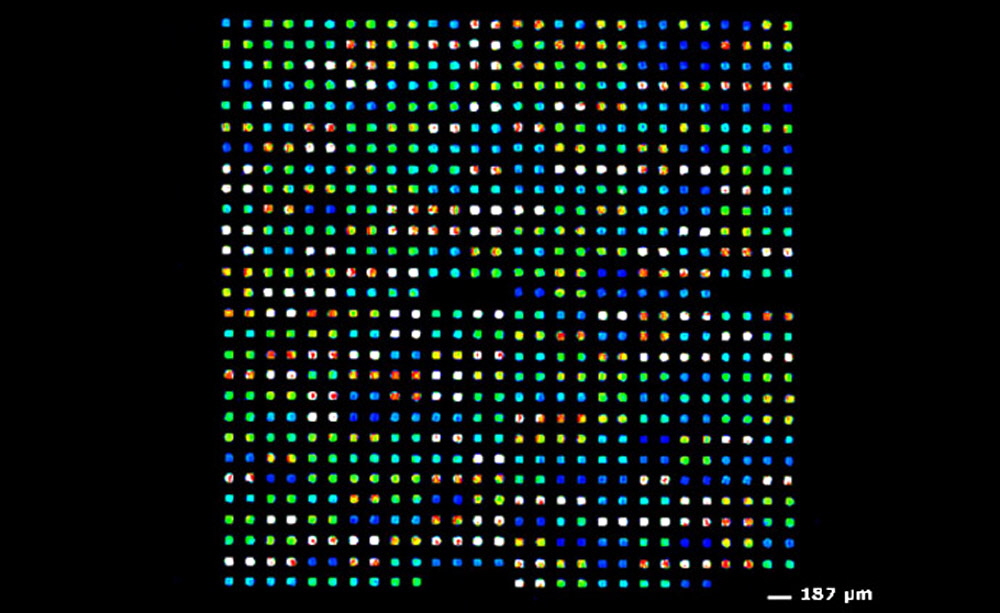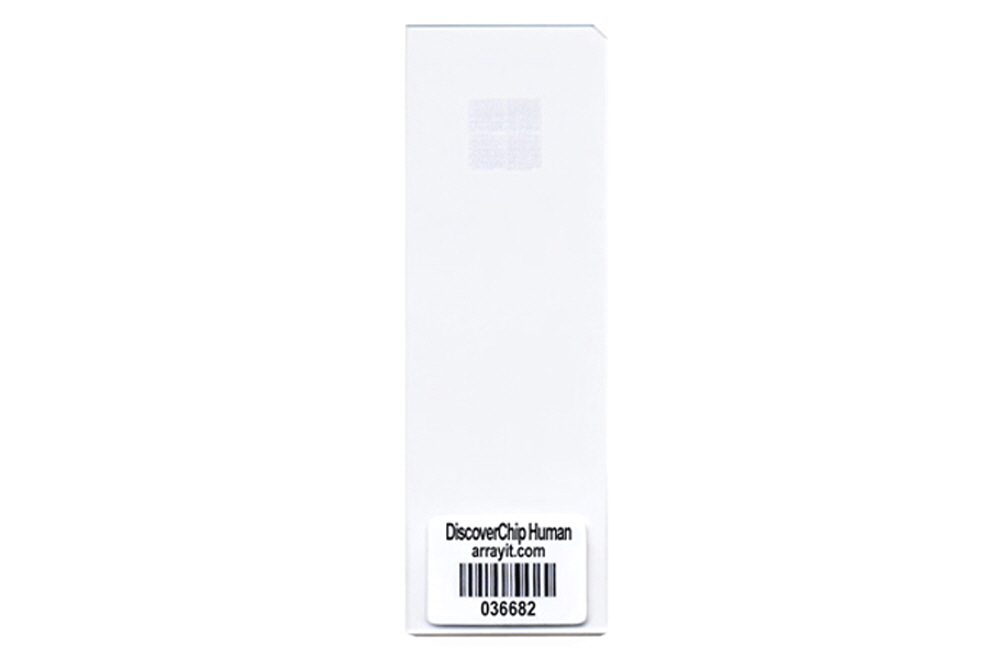DNA microarrays DCH
Data Sheet
![]() Shop this product in our online store
Shop this product in our online store
Discover Chips™ are oligonucleotide microarrays containing 380 gene sequences selected from major cellular pathways for broad coverage of physiological and transcriptional information. Four ArrayControls™ are included among the 380 gene sequences, to ensure hybridization specificity and to allow users to spike in control mRNAs for greater quantification. Each oligonucleotide sequence is printed in duplicate for tight CVs. Discover Chips™ are available for human, mouse, rat and Arabidopsis, allowing users to explore biology in biology’s most highly studied organisms. Long oligos were designed using the ArrayIt® Oligo Design Directive and manufacturing is performed in class 1 cleanrooms using the ArrayIt® patented printing technology, along with advanced surfaces and print buffers. These attributes combine to afford Discover Chips™ of incomparable quality.

Discover Chips™ are oligonucleotide microarrays containing 380 gene sequences selected from major cellular pathways for broad coverage of physiological and transcriptional information. Four ArrayControls™ are included among the 380 gene sequences, to ensure hybridization specificity and to allow users to spike in control mRNAs for greater quantification. Each oligonucleotide sequence is printed in duplicate for tight CVs. Discover Chips™ are available for human, mouse, rat and Arabidopsis, allowing users to explore biology in biology’s most highly studied organisms. Long oligos were designed using the ArrayIt® Oligo Design Directive and manufacturing is performed in class 1 cleanrooms using the ArrayIt® patented printing technology, along with advanced surfaces and print buffers. These attributes combine to afford Discover Chips™ of incomparable quality.

Figure 1. Discover Chips™ contain 768 oligonucleotide features representing 384 oligonucleotides printed in duplicate in a 9 x 9 mm area on 25 x 76 mm atomically flat glass substrate slide. Spot spacing is 187 µm and each Discover Chips™ microarray is bar-coded for ease of identification and sample tracking. Discover Chips™ are compatible with every major brand of hybridization station, processing hardware, microarray scanner, and quantification and data mining software for ultimate user flexibility.
Short Protocol (Steps 1-6)
1. Process the ArrayIt® Discover Chips™ microarray to remove excess target sequences.
2. Block the microarray surface to reduce background fluorescence.
3. Hybridize the microarray with a labeled probe mixture.
4. Wash the microarray to remove unbound probe molecules.
5. Scan the microarray to detect fluorescent signals.
6. Quantify and model the Discover Chips™ data.
Complete Protocol (Steps 1-6)
1. Process the Discover Chips™ microarray to remove excess target sequences. Remove the Discover Chips™ microarray from the package and place it the rack of an ArrayIt® High-Throughput Wash Station. Process the microarray by washing for 5 min in 2X SSC + 0.1% SDS, 5 min in 2X SSC, and 1 min in 0.1X SSC. Transfer the microarray to a steel slide rack and place in boiling dH2O for 30 sec. Transfer the microarray to 100% ethanol for 10 sec. Spin the microarray dry for 10 sec using an ArrayIt® Microarray High-Speed Centrifuge. These steps remove excess oligonucleotides from the microarray surface and prepare the microarray for the blocking step.
2. Block the microarray surface to reduce background fluorescence. Obtain a 22 x 22 mm glass cover slip and make sure the cover slip is clean and free of oils and particulates. Cover slips can be washed using ArrayIt® Micro Cleaning Solution. Place 10 µl of 1X ArrayIt® BlockIt™ Blocking Solution under a 22 x 22 mm cover slip and block the Discover Chips™ microarray surface for 60 min at room temperature. To block a large number of Discover Chips™ microarrays simultaneously, blocking may also be performed in batch using 1X ArrayIt® BlockIt™ Blocking Solution in an ArrayIt® High-Throughput Wash Station. Batch blocking is also performed for 60 min at room temperature. After the 60 min blocking step, place the Discover Chips™ microarray into High-Throughput Wash Station and wash for 1 min in dH2O. Spin the microarray dry for 10 sec using an ArrayIt® Microarray High-Speed Centrifuge.
3. Hybridize the microarray with a labeled probe mixture. Prepare labeled probe mixtures by labeling messenger RNA (mRNA) with fluorescent nucleotides, amino-allyl derivatives, and other types of nucleotides. Labeling may be performed using reverse transcriptase to generate labeled cDNA. Amplified RNA (aRNA) may also be labeled using T7 polymerase and other approaches. ArrayIt® Discover Chips™ microarrays contain sense-strand target sequences bound to the glass substrate, so hybridization requires that the probe molecules contain anti-sense cDNA and RNA sequences. Suspend 1.0 µg of labeled cDNA or RNA in 10 µl of 1X HybIt® Hybridization Solution and hybridize the microarray for 3 hours at 65°C under at 22 x 22 mm glass cover slip. The labeled cDNA or RNA may also be suspended in 10 µl of 1X HybIt® 2 Hybridization Solution and hybridized for 3 hours at 42°C under a 22 x 22 mm glass cover slip. Hybridizations are performed using ArrayIt® Hybridization Cassettes submerged in a water bath set at 65°C (HybIt®) or 42°C (HybIt® 2).
4. Wash the microarray to remove unbound probe molecules. Immediately following the hybridization step, quickly remove the microarray from the ArrayIt® Hybridization Cassette and place it in a ArrayIt® High-Throughput Wash Station containing 500 ml of 1X ArrayIt® Wash Buffer A. Wash the Discover Chips™ microarray in Wash Buffer A for 5 min at room temperature, making sure to remove the glass cover slip from the surface as quickly as possible in the first wash. Transfer the microarray to a second ArrayIt® High-Throughput Wash Station containing 500 ml of 1X ArrayIt® Wash Buffer B and wash the Discover Chips™ microarray for 5 min at room temperature. Transfer the microarray to a third ArrayIt® High-Throughput Wash Station containing 500 ml of 1X ArrayIt® Wash Buffer C and wash the Discover Chips™ microarray in Wash Buffer C for 5 min at room temperature. After the three wash steps, dry the microarray for 10 sec using an ArrayIt® Microarray High-Speed Centrifuge.
5. Scan the microarray to detect fluorescent signals. Place the ArrayIt® Discover Chips™ microarray into an ArrayIt® InnoScan® Microarray Scanner or a SpotLight™ Microarray Scanner and scan the microarray to detect green (e.g. Cy3) and red (e.g. Cy5) fluorescent signals. Scanner settings should be set to capture as many unsaturated spots as possible. Multiple images can be acquired and saved to increase the dynamic range of the assay. The 380 gene sequences from human (DCH), mouse (DCM), rat (DCR) or Arabidopsis (DCA) should appear as duplicate spots in a 9 x 9 mm area at the top of the glass substrate slide, as depicted as shown in Fig. 1. Scanned images should be saved as standard 16-bit TIFF format for data analysis.
6. Quantify and model the Discover Chips™ data. Quantify the fluorescent signals obtained at each printed location and save the data in a tab-delimited format. These data can be combined with the gene annotations provided in links below. Accession numbers for each Discover Chips™ gene can be used to explore the biochemical function of each gene. Databases containing expression profiles from multiple Discover Chips™ microarrays can provide insights into signaling pathways and other physiologically important processes.
Scientific Publications
Click here and here for recent scientific publications using Arrayit microarray products for discovery-based experimentation.
Recommended Equipment and Reagents
NanoPrint™ Microarrayers
SpotBot® 4 Personal Microarrayers
InnoScan® Microarray Scanners
SpotLight™ Microarray Scanners
SuperMicroarray Substrates
Microarray Hybridization Cassettes
High Throughput Wash Station
Microarray High-Speed Centrifuge
Protein Printing Buffer
BlockIt Blocking Buffer
Microarray Air Jet
Microarray Cleanroom Wipes
PCR Purification Kits
Micro-Total RNA Extraction Kit
MiniAmp mRNA Amplification Kit
Indirect Amino Allyl Fluorescent Labeling Kit
Universal Reference mRNA
Green540 and Red640 Reactive Fluorescent Dyes
Hybridization Buffers

